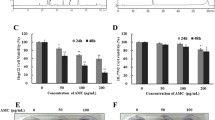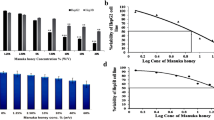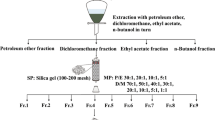Abstract
Juglans mandshurica Maxim (Juglandaceae) is a famous folk medicine for cancer treatment and some natural compounds isolated from it have been studied extensively. Previously we isolated a type of ω-9 polyunsaturated fatty acid (JA) from the bark of J. mandshurica, however little is known about its activity and the underlying mechanisms. In this study, we studied anti-tumor activity of JA on several human cancer cell lines. Results showed that JA is cytotoxic to HepG2, MDA-MB-231, SGC-7901, A549 and Huh7 cells at a concentration exerting minimal toxic effects on L02 cells. The selective toxicity of JA was better than other classical anti-cancer drugs. Further investigation indicated that JA could induce cell apoptosis, characterized by chromatin condensation, DNA fragmentation and activation of the apoptosis-associated proteins such as Caspase-3 and PARP-1. Moreover, we investigated the cellular apoptosis pathway involved in the apoptosis process in HepG2 cells. We found that proteins involved in mitochondrion (cleaved-Caspase-9, Apaf-1, HtrA2/Omi, Bax, and Mitochondrial Bax) and endocytoplasmic reticulum (XBP-1s, GRP78, cleaved-Caspase-7 and cleaved-Caspase-12) apoptotic pathways were up-regulated when cells were treated by JA. In addition, a morphological change in the mitochondrion was detected. Furthermore, we found that JA could inhibit DNA synthesis and induce G2/M cell cycle arrest. The expression of G2-to-M transition related proteins, such as CyclinB1 and phosphorylated-CDK1, were reduced. In contrast, the G2-to-M inhibitor p21 was increased in JA-treated cells. Overall, our results suggest that JA can induce mitochondrion- and endocytoplasmic reticulum-mediated apoptosis, and G2/M phase arrest in HepG2 cells, making it a promising therapeutic agent against hepatoma.





Similar content being viewed by others
References
Murata S, Mine T, Sugihara F, Yasui D, Yamaguchi H, Ueda T, Onozawa S, Kumita S (2015) Interventional treatment for unresectable hepatocellular carcinoma. World J Gastroenterol 20(37):13453–13465. doi:10.3748/wjg.v20.i37.13453
Forner A, Llovet JM, Bruix J (2012) Hepatocellular carcinoma. Lancet 379(9822):1245–1255. doi:10.1016/S0140-6736(11)61347-0
Xu H, Yu X, Qu S, Sui D (2013) Juglone, isolated from Juglans mandshurica Maxim, induces apoptosis via down-regulation of AR expression in human prostate cancer LNCaP cells. Bioorg Med Chem Lett 23(12):3631–3634. doi:10.1016/j.bmcl.2013.04.007
Liu J, Meng M, Li C, Huang X, Di D (2008) Simultaneous determination of three diarylheptanoids and an alpha-tetralone derivative in the green walnut husks (Juglans regia L.) by high-performance liquid chromatography with photodiode array detector. J Chromatogr A 1190(1–2):80–85. doi:10.1016/j.chroma.2008.02.083
Xu HL, Yu XF, Qu SC, Zhang R, Qu XR, Chen YP, Ma XY, Sui DY (2010) Anti-proliferative effect of Juglone from Juglans mandshurica Maxim on human leukemia cell HL-60 by inducing apoptosis through the mitochondria-dependent pathway. Eur J Pharmacol 645(1–3):14–22. doi:10.1016/j.ejphar.2010.06.072
Kim SH, Lee KS, Son JK, Je GH, Lee JS, Lee CH, Cheong CJ (1998) Cytotoxic compounds from the roots of Juglans mandshurica. J Nat Prod 61(5):643–645. doi:10.1021/np970413mnp970413m
Zhao MH, Jiang ZT, Liu T, Li R (2014) Flavonoids in Juglans regia L. leaves and evaluation of in vitro antioxidant activity via intracellular and chemical methods. Sci World J 2014:303878. doi:10.1155/2014/303878
Li YX, Zhang YW, Bao YL, Lin H, Zheng LH, Yu CL (2011) (7E,9E)-6,11-Dioxooctaadeca-7,9-dienoic acid and its derivatives, preparation method and application. Peoples’ Republic of China (CN) Patent CN102173987A
Wannous R, Bon E, Maheo K, Goupille C, Chamouton J, Bougnoux P, Roger S, Besson P, Chevalier S (2013) PPARbeta mRNA expression, reduced by n-3 PUFA diet in mammary tumor, controls breast cancer cell growth. Biochim Biophys Acta 1831(11):1618–1625. doi:10.1016/j.bbalip.2013.07.010
Arita K, Kobuchi H, Utsumi T, Takehara Y, Akiyama J, Horton AA, Utsumi K (2001) Mechanism of apoptosis in HL-60 cells induced by n-3 and n-6 polyunsaturated fatty acids. Biochem Pharmacol 62(7):821–828. doi:10.1016/S0006-2952(01)00723-7
Calviello G, Palozza P, Piccioni E, Maggiano N, Frattucci A, Franceschelli P, Bartoli GM (1998) Dietary supplementation with eicosapentaenoic and docosahexaenoic acid inhibits growth of Morris hepatocarcinoma 3924A in rats: effects on proliferation and apoptosis. Int J Cancer 75(5):699–705. doi:10.1002/(SICI)1097-0215(19980302)75:5<699:AID-IJC7>3.0.CO;2-U
Zhang Y, Bao YL, Wu Y, Yu CL, Huang YX, Sun Y, Zheng LH, Li YX (2013) Alantolactone induces apoptosis in RKO cells through the generation of reactive oxygen species and the mitochondrial pathway. Mol Med Rep 8(4):967–972. doi:10.3892/mmr.2013.1640
Yao Y, Zhang YW, Sun LG, Liu B, Bao YL, Lin H, Zhang Y, Zheng LH, Sun Y, Yu CL, Wu Y, Wang GN, Li YX (2012) Juglanthraquinone C, a novel natural compound derived from Juglans mandshurica Maxim, induces S phase arrest and apoptosis in HepG2 cells. Apoptosis 17(8):832–841. doi:10.1007/s10495-012-0722-5
Creagh EM (2014) Caspase crosstalk: integration of apoptotic and innate immune signalling pathways. Trends Immunol 35(12):631–640. doi:10.1016/j.it.2014.10.004
Hitomi J, Katayama T, Taniguchi M, Honda A, Imaizumi K, Tohyama M (2004) Apoptosis induced by endoplasmic reticulum stress depends on activation of caspase-3 via caspase-12. Neurosci Lett 357(2):127–130. doi:10.1016/j.neulet.2003.12.080S0304394003014721
Liang B, Song X, Liu G, Li R, Xie J, Xiao L, Du M, Zhang Q, Xu X, Gan X, Huang D (2007) Involvement of TR3/Nur77 translocation to the endoplasmic reticulum in ER stress-induced apoptosis. Exp Cell Res 313(13):2833–2844. doi:10.1016/j.yexcr.2007.04.032
Li P, Nijhawan D, Budihardjo I, Srinivasula SM, Ahmad M, Alnemri ES, Wang X (1997) Cytochrome c and dATP-dependent formation of Apaf-1/caspase-9 complex initiates an apoptotic protease cascade. Cell 91(4):479–489. doi:10.1016/S0092-8674(00)80434-1
Kuwahara D, Tsutsumi K, Oyake D, Ohta T, Nishikawa H, Koizuka I (2003) Inhibition of caspase-9 activity and Apaf-1 expression in cisplatin-resistant head and neck squamous cell carcinoma cells. Auris Nasus Larynx 30(Suppl):S85–S88. doi:10.1016/S0385-8146(02)00129-3
Goo HG, Rhim H, Kang S (2014) HtrA2/Omi influences the stability of LON protease 1 and prohibitin, proteins involved in mitochondrial homeostasis. Exp Cell Res 328(2):456–465. doi:10.1016/j.yexcr.2014.07.032
Liu WH, Chang LS (2011) Fas/FasL-dependent and -independent activation of caspase-8 in doxorubicin-treated human breast cancer MCF-7 cells: ADAM10 down-regulation activates Fas/FasL signaling pathway. Int J Biochem Cell Biol 43(12):1708–1719. doi:10.1016/j.biocel.2011.08.004
Rao RV, Ellerby HM, Bredesen DE (2004) Coupling endoplasmic reticulum stress to the cell death program. Cell Death Differ 11(4):372–380. doi:10.1038/sj.cdd.44013784401378
Choi EJ, Kim GH (2008) Daidzein causes cell cycle arrest at the G1 and G2/M phases in human breast cancer MCF-7 and MDA-MB-453 cells. Phytomedicine 15(9):683–690. doi:10.1016/j.phymed.2008.04.006
Xu HL, Yu XF, Qu SC, Qu XR, Jiang YF, da Sui Y (2012) Juglone, from Juglans mandshurica Maxim, inhibits growth and induces apoptosis in human leukemia cell HL-60 through a reactive oxygen species-dependent mechanism. Food Chem Toxicol 50(3–4):590–596. doi:10.1016/j.fct.2012.01.002
Zand H, Rhimipour A, Bakhshayesh M, Shafiee M, Nour Mohammadi I, Salimi S (2007) Involvement of PPAR-gamma and p53 in DHA-induced apoptosis in Reh cells. Mol Cell Biochem 304(1–2):71–77. doi:10.1007/s11010-007-9487-5
Borghetti G, Yamaguchi AA, Aikawa J, Yamazaki RK, de Brito GA, Fernandes LC (2015) Fish oil administration mediates apoptosis of Walker 256 tumor cells by modulation of p53, Bcl-2, caspase-7 and caspase-3 protein expression. Lipids Health Dis 14(1):94. doi:10.1186/s12944-015-0098-y10.1186/s12944-015-0098-y
Sun SN, Jia WD, Chen H, Ma JL, Ge YS, Yu JH, Li JS (2013) Docosahexaenoic acid (DHA) induces apoptosis in human hepatocellular carcinoma cells. Int J Clin Exp Pathol 6(2):281–289
Kang JX, Liu A (2012) The role of the tissue omega-6/omega-3 fatty acid ratio in regulating tumor angiogenesis. Cancer Metastasis Rev 32(1–2):201–210. doi:10.1007/s10555-012-9401-9
Fleischer A, Ghadiri A, Dessauge F, Duhamel M, Rebollo MP, Alvarez-Franco F, Rebollo A (2006) Modulating apoptosis as a target for effective therapy. Mol Immunol 43(8):1065–1079. doi:10.1016/j.molimm.2005.07.013
Cain K, Bratton SB, Cohen GM (2002) The Apaf-1 apoptosome: a large caspase-activating complex. Biochimie 84(2–3):203–214. doi:10.1016/S0300-9084(02)01376-7
Reubold TF, Wohlgemuth S, Eschenburg S (2011) Crystal structure of full-length Apaf-1: how the death signal is relayed in the mitochondrial pathway of apoptosis. Structure 19(8):1074–1083. doi:10.1016/j.str.2011.05.013
Xiong S, Mu T, Wang G, Jiang X (2014) Mitochondria-mediated apoptosis in mammals. Protein Cell 5(10):737–749. doi:10.1007/s13238-014-0089-1
Feng R, Han J, Ziegler J, Yang M, Castranova V (2012) Apaf-1 deficiency confers resistance to ultraviolet-induced apoptosis in mouse embryonic fibroblasts by disrupting reactive oxygen species amplification production and mitochondrial pathway. Free Radic Biol Med 52(5):889–897. doi:10.1016/j.freeradbiomed.2011.11.028
Arya R, White K (2015) Cell death in development: signaling pathways and core mechanisms. Semin Cell Dev Biol 39:12–19. doi:10.1016/j.semcdb.2015.02.001
Siu WP, Pun PB, Latchoumycandane C, Boelsterli UA (2008) Bax-mediated mitochondrial outer membrane permeabilization (MOMP), distinct from the mitochondrial permeability transition, is a key mechanism in diclofenac-induced hepatocyte injury: multiple protective roles of cyclosporin A. Toxicol Appl Pharmacol 227(3):451–461. doi:10.1016/j.taap.2007.11.030
Palmer CS, Osellame LD, Stojanovski D, Ryan MT (2011) The regulation of mitochondrial morphology: intricate mechanisms and dynamic machinery. Cell Signal 23(10):1534–1545. doi:10.1016/j.cellsig.2011.05.021
Tabas I, Ron D (2011) Integrating the mechanisms of apoptosis induced by endoplasmic reticulum stress. Nat Cell Biol 13(3):184–190. doi:10.1038/ncb0311-184
Lu TH, Su CC, Tang FC, Chen CH, Yen CC, Fang KM, Lee KI, Hung DZ, Chen YW (2014) Chloroacetic acid triggers apoptosis in neuronal cells via a reactive oxygen species-induced endoplasmic reticulum stress signaling pathway. Chem Biol Interact 225:1–12. doi:10.1016/j.cbi.2014.10.022
Inoue T, Suzuki-Karasaki Y (2012) Mitochondrial superoxide mediates mitochondrial and endoplasmic reticulum dysfunctions in TRAIL-induced apoptosis in Jurkat cells. Free Radic Biol Med 61:273–284. doi:10.1016/j.freeradbiomed.2013.04.020
de la Cadena SG, Hernandez-Fonseca K, Camacho-Arroyo I, Massieu L (2013) Glucose deprivation induces reticulum stress by the PERK pathway and caspase-7- and calpain-mediated caspase-12 activation. Apoptosis 19(3):414–427. doi:10.1007/s10495-013-0930-7
Arellano M, Moreno S (1997) Regulation of CDK/cyclin complexes during the cell cycle. Int J Biochem Cell Biol 29(4):559–573. doi:10.1016/S1357-2725(96)00178-1
Afrasiabi E, Blom T, Balthasar S, Tornquist K (2007) Antiproliferative effect of sphingosylphosphorylcholine in thyroid FRO cancer cells mediated by cell cycle arrest in the G2/M phase. Mol Cell Endocrinol 274(1–2):43–52. doi:10.1016/j.mce.2007.05.016
Acknowledgments
We thank Chunlei Yu, Yanxiang Guo and Yao Yao for helpful guidance in experiment methods, Guannan Wang and Xiuli Wang for electron microscopy technology. This work was supported by grants from the National Natural Science Foundation of China (Nos. 31170324 and 31070318), the Fundamental Research Funds for the Central Universities (No. 11QNJJ021), and the Research Foundation of Jilin Provincial Science and Technology Development (No. 20140203008YY).
Author information
Authors and Affiliations
Corresponding authors
Ethics declarations
Conflict of interest
The authors declare that they have no conflict of interest.
Electronic supplementary material
Below is the link to the electronic supplementary material.
Rights and permissions
About this article
Cite this article
Gao, XL., Lin, H., Zhao, W. et al. JA, a new type of polyunsaturated fatty acid isolated from Juglans mandshurica Maxim, limits the survival and induces apoptosis of heptocarcinoma cells. Apoptosis 21, 340–350 (2016). https://doi.org/10.1007/s10495-015-1202-5
Published:
Issue Date:
DOI: https://doi.org/10.1007/s10495-015-1202-5




